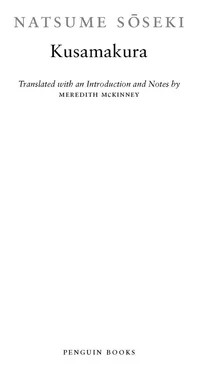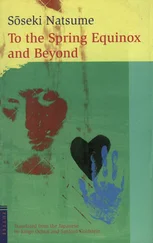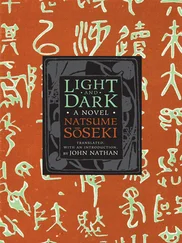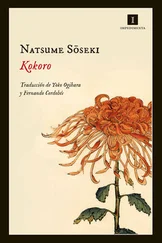Natsume Soseki - Kusamakura
Здесь есть возможность читать онлайн «Natsume Soseki - Kusamakura» весь текст электронной книги совершенно бесплатно (целиком полную версию без сокращений). В некоторых случаях можно слушать аудио, скачать через торрент в формате fb2 и присутствует краткое содержание. Жанр: Старинная литература, на английском языке. Описание произведения, (предисловие) а так же отзывы посетителей доступны на портале библиотеки ЛибКат.
- Название:Kusamakura
- Автор:
- Жанр:
- Год:неизвестен
- ISBN:нет данных
- Рейтинг книги:4 / 5. Голосов: 1
-
Избранное:Добавить в избранное
- Отзывы:
-
Ваша оценка:
- 80
- 1
- 2
- 3
- 4
- 5
Kusamakura: краткое содержание, описание и аннотация
Предлагаем к чтению аннотацию, описание, краткое содержание или предисловие (зависит от того, что написал сам автор книги «Kusamakura»). Если вы не нашли необходимую информацию о книге — напишите в комментариях, мы постараемся отыскать её.
Kusamakura — читать онлайн бесплатно полную книгу (весь текст) целиком
Ниже представлен текст книги, разбитый по страницам. Система сохранения места последней прочитанной страницы, позволяет с удобством читать онлайн бесплатно книгу «Kusamakura», без необходимости каждый раз заново искать на чём Вы остановились. Поставьте закладку, и сможете в любой момент перейти на страницу, на которой закончили чтение.
Интервал:
Закладка:
“They’re by Mokubei,†he remarks simply.2
“They’re delightful,†I say, in equal y simple praise.
“There are a lot of fake Mokubeis around. Look at the base. You’l find his signature there.â€
I lift it up and turn it toward the paper-screened window to see. The warm shadow of a potted aspidistra fal s across the screen. Sure enough, when I twist my head to look closely at the base, I see the single smal character “Moku.†A signature is not real y important in appreciating a work of art, but dilettantes apparently set great store by it. I bring the raised cup directly to my lips. A connoisseur with time on his hands wil elegantly taste this rich, delicately sweet liquid, ripened in the precise temperature of the hot water, by letting it run one drop at a time onto the tip of the tongue. Most people believe that tea is to be drunk, but that is a mistake. If you drop it gently onto the tongue and let the pure liquid dissipate in your mouth, almost none of it remains for you to swal ow.
Rather, the exquisite fragrance travels down to permeate the regions of the stomach. Using the teeth on solid food is vulgar, while mere water is insipid. The best green tea, on the other hand, surpasses fresh water in its delicate, rich warmth, yet lacks the firmness of more solid substances that tire the jaw. Tea is, in fact, a marvelous drink. To those who spurn it on the grounds of insomnia, I say that it’s better to be deprived of sleep than of tea.
I next turn my attention to a blue stone tea-sweets dish that the old man has now produced and is passing around. It is nothing short of astonishing to consider the fine dexterity of the master craftsman who has carved such a large piece of stone to such thinness, and with such delicate precision! Spring sunlight shines through the translucent stone, seemingly captured and held there within its depths. It is right that such a plate remains empty.
“I brought this out to show our guest here. He’s been kind enough to admire my celadon, so I thought I’d bring out a few more things for him to see today.â€
“What celadon would that be?†the abbot asks. “Oh, you mean the tea-sweets dish? I’m fond of that one myself, yes. By the way, I don’t suppose Western pictures can be painted onto sliding doors, can they? If they can, then I’d like you to do me one.â€
Wel , I think, I could do it if asked, but I don’t know that it would be to the abbot’s taste. There’s no point in slaving to produce such a thing if he then declares that he doesn’t like Western painting.
“I don’t think Western painting would work for sliding doors,†I say.
“You don’t, eh? Yes, that’s true, I suppose it would be a bit garish if it’s the sort of thing I saw Kyuichi painting the other day.â€
“My paintings are terrible,†protests the youth earnestly, looking most embarrassed. “I’m just messing around.â€
“Where is that pond you were speaking of?†I ask the young man, from idle curiosity.
“It’s a lovely tranquil place, in the val ey behind Kankaiji temple. It’s just that I studied Western painting a little at school, you see, so I thought I’d stop by there and try my hand when I was feeling bored one day, that’s al .â€
“And this Kankaiji temple . . . ?â€
“That’s where I am,†the abbot breaks in. “A fine place. You can take in the whole sea at a glance from up there. Come and have a look while you’re staying. It’s only a half mile or so from here. From the corridor out there you can see the stone steps going up to it, have you noticed?â€
“Could I come for a visit sometime?â€
“Of course, of course. I’m always there. Mr. Shioda’s daughter cal s in quite a lot. Speaking of which,†he says, turning to the old gentleman, “there’s no sign of your Nami today. She’s al right, I hope?â€
“She must have gone out somewhere. Did she go to your place by any chance, KyÅ«ichi?â€
“No, she wasn’t there.â€
“Probably off on a walk by herself again,†says the abbot with a laugh. “She’s got strong legs, has Nami. When I was out at Tonami the other day for a ceremony, I thought to myself, ‘Good heavens, that looks like Nami there on Sugatami Bridge,’ and sure enough it was.
She was wearing straw sandals and had her skirts tucked up behind. ‘What are you doing loitering around here, Your Reverence?’ she says to me, quite out of the blue. ‘Where are you off to?’ Gave me quite a surprise, ha ha. ‘Where in heaven’s name have you been, dressed like that?’ I ask. ‘I’m just back from picking wild parsley,’ says she. ‘Here, I’l give you a bit.’ And she suddenly shoves a muddy bunch of it into my sleeve, ha ha.â€
“Dear me . . .†says old Mr. Shioda, with a pained smile. Then he abruptly rises to his feet and turns the subject hastily back to curios. “I rather wanted to show you this.â€
He reverently takes down from the sandalwood bookcase a little bag made of fine old patterned damask. It seems to contain some heavy object.
“Have you ever seen this, Your Reverence?â€
“What on earth is it?â€
“An ink stone.â€
“That so? What sort of ink stone?â€
“It was a favorite piece in Sanyo’s col ection.â€3
“No, I haven’t seen that one.â€
“It has a spare lid done by Shunsui.â€
“No, haven’t seen it. Show me, show me.â€
The old man tenderly undoes the bag, revealing a corner of the russet stone within.
“That’s a lovely color. Tankei, would it be?â€4
“Yes, and there are nine ‘shrike spots.’â€
“Nine?†repeats the abbot incredulously, evidently deeply impressed.
“This is the Shunsui lid,†says Mr. Shioda, displaying a thin lid in a figured satin wrapping. A Chinese poem of seven characters is written on it in Shunsui’s cal igraphic hand.
“Ah, yes. He had a fine hand, a fine hand—though, mind you, Kyohei wrote a better one.â€5
“You think so, do you?â€
“I’d say Sanyo was the worst of them. That tendency to cleverness made him vulgar. Nothing interesting in him at al .â€
The old gentleman chuckles. “I know you’re no fan of Sanyo, so I changed his scrol for a different one today.â€
“That so?†The abbot turns to look over his shoulder. The alcove is a simple recess in the wal . On its polished board stands an old Chinese copperware vase, its surface elegantly tarnished, with a two-foot-high branch of magnolia blossom arranged in it. The scrol hanging behind it is a large work by Sorai,6 on a backing of subtly glowing figured silk. The cal igraphy is on paper rather than the more usual silk, but the scrol ’s beauty lies not only in the indisputable skil of the writing itself but also in the delightful harmony between the backing and the paper, which has aged with the passage of time. The figured silk itself is not particularly wonderful, but it seems to me to achieve its fine quality through a combination of faded color and a softening of the effect of the gold thread, so that any original gaudiness has dimmed, al owing a certain austerity to assert itself.
The two little ivory scrol ends protrude starkly white against the tea-brown background of the earth wal , while before the scrol softly floats the pale magnolia blossoms, yet the overal effect of the alcove is so calm as to be almost gloomy.
Читать дальшеИнтервал:
Закладка:
Похожие книги на «Kusamakura»
Представляем Вашему вниманию похожие книги на «Kusamakura» списком для выбора. Мы отобрали схожую по названию и смыслу литературу в надежде предоставить читателям больше вариантов отыскать новые, интересные, ещё непрочитанные произведения.
Обсуждение, отзывы о книге «Kusamakura» и просто собственные мнения читателей. Оставьте ваши комментарии, напишите, что Вы думаете о произведении, его смысле или главных героях. Укажите что конкретно понравилось, а что нет, и почему Вы так считаете.












